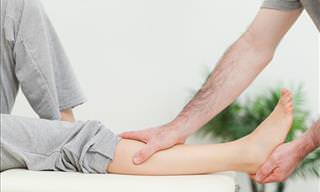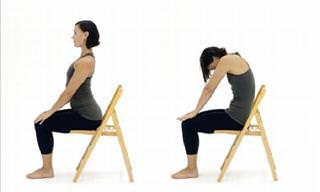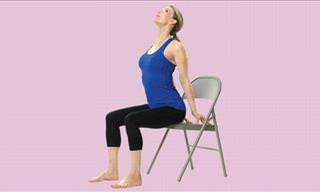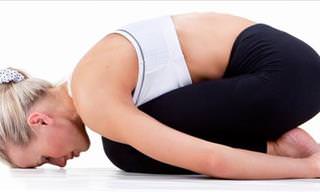Type 2 diabetes affects 29.1 million people in the United States, 8.1 million of whom may be unaware of their condition. It occurs when the body doesn't use the hormone insulin properly. As a result, when insulin is not doing its job, blood sugar levels rise, causing health problems. However, lifestyle changes, including regular exercise, can help manage diabetes.
How Yoga Can Help Manage Diabetes
Your exercise regime need not only be limited to biking or jogging. Studies show that yoga can be just as beneficial. In fact, this ancient practice has been found to help lower blood pressure and improve blood glucose levels. Yoga is also recommended for stress management, as stress elevates blood sugar, which can lead to further diabetes complications. Furthermore, yoga invites us to center ourselves. This act of centering calms us down, thus balancing our blood sugar levels. Yoga also brings about mindfulness, which involves staying and living in the moment. This is a helpful tool that can have lasting, fruitful behavior changes, and is a must for managing diabetes.
In fact, in one study, researchers found that people that scored highly at mindfulness were more likely to have healthy glucose levels than people who had lower scores. But exactly how mindfulness plays a role on glucose levels is not yet understood. In another study published in March 2016, in the American Journal of Health Behavior, it was found that mindful people are less likely to be obese. Furthermore, among 33 studies conducted on the topic, yoga was found to improve blood sugar control, cholesterol profiles and weight. Yoga was also found to lower blood pressure, enhance lung function, mood, sleep and quality of life. To manage your diabetes, here are 10 yoga poses you can try:
10 Yoga Poses to Keep Your Diabetes Under Control
While some of these poses are suitable for beginners and can be practiced in your own time at home, it is advised that others should be practiced under the guidance of a qualified yoga instructor.
Deep breathing
Suitable for: Beginners
Benefits: Deep breathing helps oxygenate the blood, improving circulation. It helps calm the mind and gives the nerves some much-needed rest.
Here's How:
1. Sit in a comfortable position. Keep your spine long and straight and hands on your knees, palms facing up and your belly slightly tucked in. Draw your shoulder blades slightly together and down your back, simultaneously drawing your shoulders down and away from your ears. Keep your chin parallel to the floor and your jaw relaxed. Close your eyes.
2. Connect with your natural breath, becoming aware of each inhale and exhale for a couple of rounds. Then, breathe in deeply through your nose. At the peak of your inhale, hold your breath for five counts and slowly exhale through your nose, emptying the lungs completely. Repeat the process for 10 rounds.
3. After the last round, rub your palms together until they are warm and place them over your eyes. This process, known as palming, relaxes the whole body and mind. Slowly open your eyes.
Child's Pose
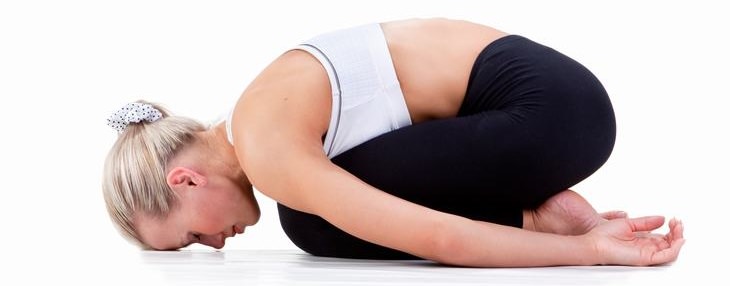
Suitable for: Beginners
Benefits: The Child's pose is a great stress reliever. It stretches the hips, thighs and ankles and helps calm the mind, relieving stress and fatigue. This pose will gently stretch the lower back muscles, relieving any pain from long hours of sitting.
Modifications: For extra comfort, place a rolled up blanket at the back of your knees. A cushion or folded blanket may be used to support your forehead.
Here's How:
1. Come onto all fours in a cat pose and place blankets at the back of your knees if needed. Release your buttocks towards your heels and spread your thighs slightly apart.
2. Allow your torso to rest on your thighs and keep your arms extended out in front of you, simultaneously elongating your spine.
3. If you have the flexibility, allow your forehead to rest on the floor. Alternatively, you may place your forehead on a cushion or an exercise block.
4. Once in the pose, draw your attention to your breath, breathing at a normal pace.
5. Hold the pose for 5 to 10 breaths, or up to 3 minutes.
Contraindications: Do not practice this pose if you are pregnant, have a knee injury or have diarrhea.
Hero Pose
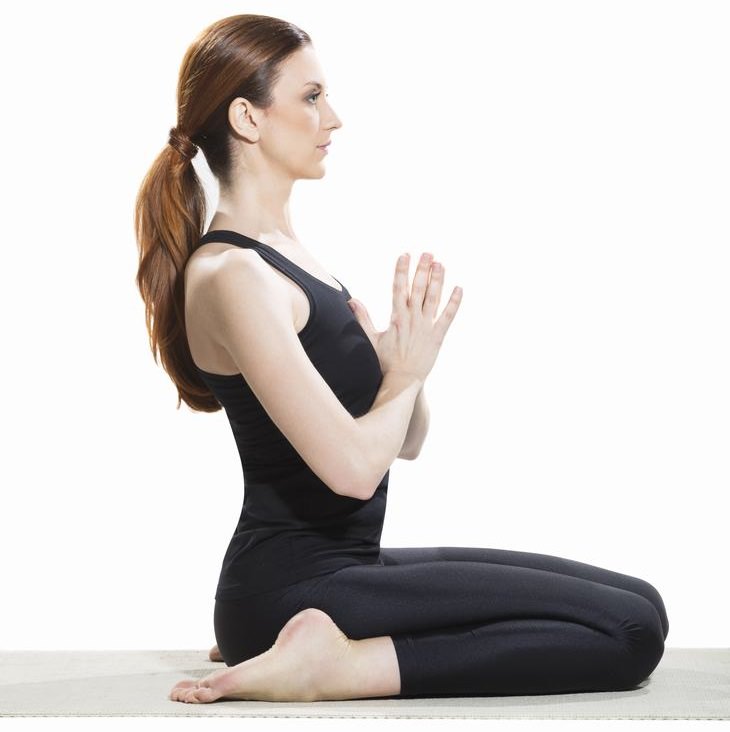
Suitable for: Beginners
Benefits: This simple pose relaxes the mind and improves digestion. It also massages the kanda - a point located 12 inches above the base of your spine, which is, according to the ancient practice of ayurveda, said to be the point of convergence for over 72,000 nerves.
Modification: Pictured, is the modified version of the actual pose. You may place a cushion or a folded blanket at the back of your knees.
Here's How:
1. Come onto all fours in cat pose. If practicing on a yoga mat, fold the mat in two, providing extra support for the knees. Place a blanket or cushion at the backs of your knees for extra support if desired.
2. Release your buttocks onto your heels. Keep your palms on your knees facing downwards. Close your eyes and breathe deeply at a steady pace. Hold for 5 to 10 breaths, or up to three minutes.
Bow Pose
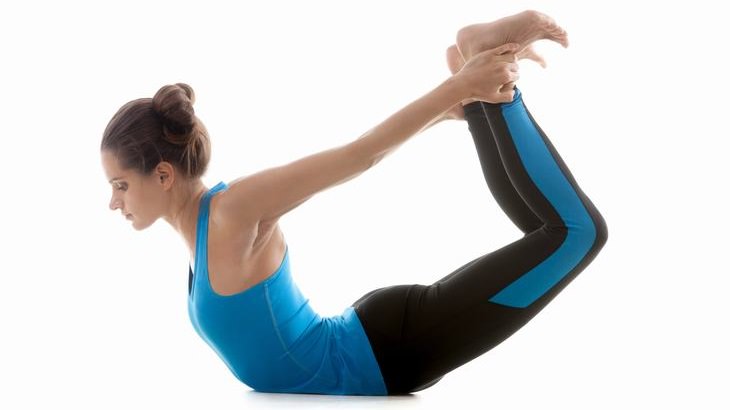
Suitable for: Beginners (modified version)
Benefits: A fantastic pose to strengthen the back and the spine. It helps to stimulate the reproductive organs, beat stress and fatigue and relieve menstrual pain and constipation.
Modifications: Lifting the thighs in this pose may be challenging. For extra support, place a folded blanket under your pelvis and thighs. Use a yoga belt (or other similar accessory) to grab a hold of your ankles if needed.
Here's How:
1. Lie down on your stomach, with a blanket under your pelvis and thighs if needed. Keep your feet hip-width apart and your arms by the side of your body.
2. Fold your knees and lift your arms, reaching to wrap your hands around the outside of your ankles. If needed, use a yoga belt or similar accessory to help grab a hold of your ankles.
3. Take a deep breath in and lift your chest off the ground. You can stop here. If you find the strength in your legs and glutes as well as the flexibility in your lower back, pull your legs up and back.
4. Keep your eyes fixed at a point, looking straight ahead. Draw your attention to your breath, taking long deep breaths, enabling you to relax into the pose.
5. Hold for about 15 to 20 seconds. Exhale deeply, gently bringing your legs and chest to the ground. Release your ankles and relax.
Contraindications: Do not practice this pose if you have high or low blood pressure, a hernia, neck injury, pain in the lower back, headache, migraine or recent abdominal surgery. This pose should also be avoided if you are pregnant.
Shoulder Stand

Suitable for: Intermediate
If you are new to this pose, practice only under the guidance of a trained yoga instructor.
Benefits: A Shoulder stand is predominantly known to regulate the thyroid glands, which are responsible for the proper functioning of the entire body including the digestive, nervous and reproductive system. They also regulate the metabolism and respiratory system. This pose is also beneficial for the spine, supplying the blood with oxygen. It also helps with nervous system disorders and improves overall health.
Modifications: Fold two or more blankets into rectangles, measuring roughly one foot by two feet. Stack the blankets one on top of the other. To keep your arms in place while in the pose, you can place a sticky mat on top. Lie on the blankets with your shoulders supported and parallel to one of the longer edges of the blanket. Keep your head on the floor.
Here's How:
1. Lie down over the folded blankets (for correct alignment see modifications), your legs extended outwards. Now, slowly raise your legs, drawing them to your knees, then straight up, keeping your ankles, knees and hips in alignment.
2. Use the strength in your core muscles to lift your pelvis off the floor, directing your hips over your shoulders. Place your palms along your back and hips for extra support. Keep your body extended, pointing your toes to the ceiling.
3. The weight should be on your shoulders, not on your neck, and your elbows should be parallel to one another and well-rested on the floor, giving your back the support it needs.
4. Take long deep breaths and hold the pose for as long as you may need. Then return to the lying position slowly, or proceed onto the next pose.
Contraindications: Avoid this pose if you suffer from any neck or spinal injuries, or have high blood pressure.
Plow Pose
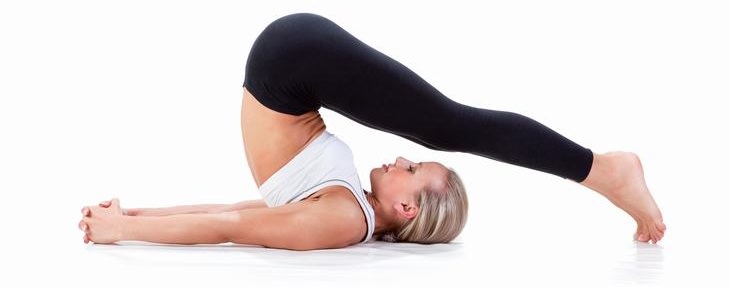
Suitable for: Intermediate
If you are new to this pose, practice only under the guidance of a trained yoga instructor.
Benefits: The Plow pose improves posture, particularly among those who sit for long hours. It stimulates the thyroid glands, parathyroid glands, lungs and abdominal organs. It encourages blood to flow to the head and the face. It improves digestion and balances hormones.
Modifications: Proceed from shoulder stand as described above, using two folded blankets underneath your shoulders. If your feet do not touch the floor, support them on a wall behind you or place them on a block.
Here's How:
1. From a shoulder stand, release your legs keeping them straight, folding at the hips. Then, take your feet behind your head. Keep your hands straight by your hips and flat on the floor, offering extra support. While in the pose, breathe deeply and hold for about 15 to 20 seconds.
2. Come out of the pose slowly. Engaging your core muscles, lift your legs up from the floor, wall or block slowly, taking your legs over your hips, simultaneously releasing your hips down to the ground, using your arms for extra support. Release your legs down to the ground, remove the blankets and proceed to the next pose.
Bridge Pose
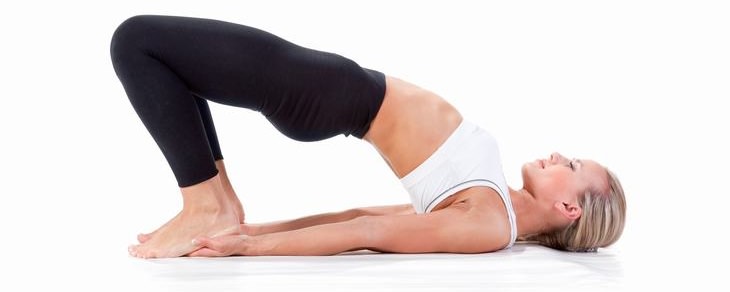
Suitable for: Beginners (modified version)
Benefits: The Bridge pose helps keep one's blood pressure under control. It helps relax the mind and improves digestion. This pose helps relieve the symptoms of menopause. It stretches the neck and the spine.
Modifications: Place a block in an upright position at the base of your spine, supporting your weight in the pose.
Here's How:
1. Lie down on your back, tailbone down, your knees bent and your feet flat on the floor, hip-width distance apart. Draw your heels as close to your buttocks as you possibly can and keep your knees rotating internally, directly over your ankles. Upon lifting your pelvis, there may be a tendency to splay your knees out to the sides, internally rotating the knees will help keep them in alignment. Keep your arms by your hips, palms facing down. Take a couple of breaths here.
2. Exhale and lift your pelvis off the floor, using the strength in your core muscles (belly and lower back) and your feet. Keep your arms by your side, pushing your hands down into the ground for extra support. Your neck and head should be flat on the floor. If you need extra support, place a block in a vertical position at the base of your spine.
3. Breathe at a normal pace and hold the pose for 15 to 20 seconds.
Contraindications: Avoid the pose if you have a neck or back injury.
Seated Spinal Twist
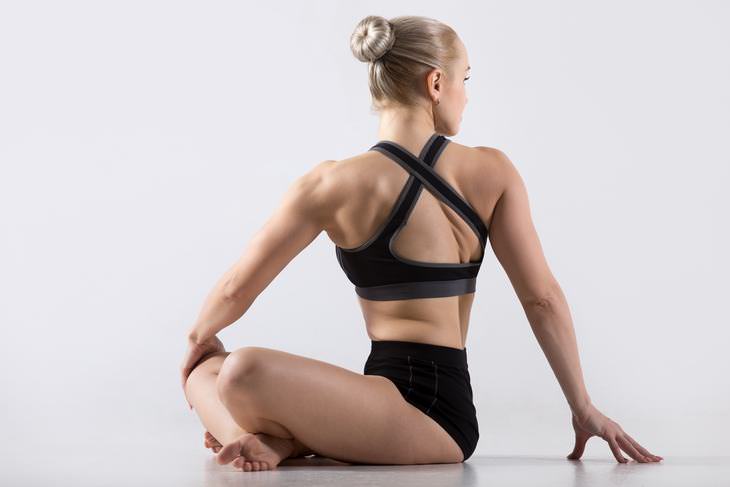
Suitable for: Beginners
Benefits: This pose increases the capacity of your lungs allowing them to inhale and hold more oxygen. It also loosens up the spine and relieves backaches and discomfort in the back.
Modifications: Sit up on a blanket and wrap your arm around your thigh, as opposed to taking your arm to the outside of your knee.
Here's How:
1. Sit with your legs straight out in front of you. Keep your spine long. Bend your left leg and place the heel of your left foot beside your right hip. Alternatively, and if you find it easier, you can keep your leg straight.
2. Now take your right leg over your left knee and place your left hand around your right knee, simultaneously taking your right hand behind you. Twist at the waist, shoulders and the neck, looking over your right shoulder. Hold for a couple of long, deep breaths.
3. Slowly come out of the pose, releasing your right hand first, your waist, your chest, and lastly your neck. Repeat on the other side.
Contraindications: Practice with caution if you have a back injury.
Forward Fold

Suitable for: Beginners
Benefits: This pose encourages blood to flow to the face. It helps the stomach function better and it strengthens your thigh muscles while relaxing the back and the arms.
Modifications: Place a rolled up blanked under your knees for extra support and comfort. Use a yoga belt or similar accessory if you do not have the flexibility to reach your toes.
Here's How:
1. Sit with your legs stretched out in front of you. Keep your hands by your hips, face down, and lengthen your spine. Take a deep inhale and as you exhale, slowly lean the torso forward, from the pelvis, keeping your spine straight. Continue to move your torso over your legs with each exhale. Grabbing a hold of your big toes (or using the yoga belt).
2. Continue to bend forward with each exhale, taking, if you can, bend your forehead to your knees. Allow your breath to help you relax into the pose and hold for 15 to 20 seconds. Slowly return to the sitting posture.
Contraindications: Be cautious if you suffer from back pain or have problems with your spine.
Lying Down Twist
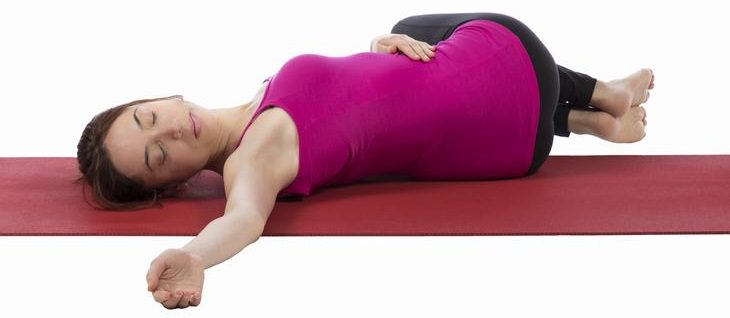
Suitable for: Beginners
Benefits: A great pose to stretch the spine and relax the back muscles. It also promotes relaxation in the mind, releasing any stress or tension.
Modifications: Rest your top knee on a firm pillow or place a folded blanket between your legs.
Here's How:
1. Lie down on your back, with your arms stretched out horizontally, keeping them in line with your shoulders. Bend your right knee, bringing your foot close to your hip (the sole of your foot should be on the ground).
2. Swing your right knee over to the left side, resting your knee on a firm pillow or folded blanket if desired. Simultaneously, turn your head to the right, looking at your right palm. Keep your shoulder blades on the floor.
3. You should feel a stretch in your thighs, groin, arms, neck, stomach and back. With each exhalation relax deeper into the pose, holding for a couple of breaths.
4. Slowly come out of the pose by turning your head back to the center, straightening the torso and then your right leg. Mirror the pose on the other side.
Contraindications: Avoid the pose if you have any spinal injury.
Images: Source
We Have 6 More Yoga Related Articles in Store for You, Here They Are:
10 Yoga Poses for Healthy Hips
7 At-Home Exercises For a Healthy Liver
These 6 Yoga Poses Will Aid Your Osteoporosis
5 Scoliosis Exercises That Will Improve Your Posture
5 Yoga Exercises to Do Before Bed
7 Yoga Exercises That’ll Help You Treat Thyroid Dysfunction
 Go to BabaMail
Go to BabaMail













